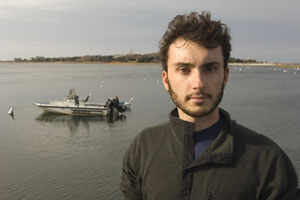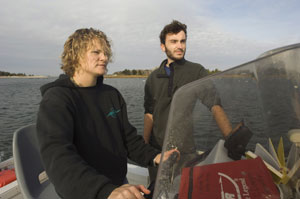 |
West Falmouth Harbor is Outdoor Classroom for MBL Environmental Science Student
 |
|
Cornell senior and SES student Jeffrey Walker is studying nitrogen pollution in West Falmouth Harbor. Photo credit: T. Kleindinst
|
|
It's a chilly November day as Jeffrey Walker and his classmates navigate their boat into West Falmouth Harbor. The students are retrieving instruments that collect light, temperature, salinity, and oxygen data from the water - information critical to understanding nitrogen pollution. Walker is a student in the MBL's Semester in Environmental Science (SES) program, an intensive 16 weeks of hands-on ecological science for college students sponsored by the MBL's Ecosystems Center. He is measuring the productivity rates of sea grasses, algae, and phytoplankton in inner and outer portions of the Harbor as part of his SES student research project. His data are just one component of a major multi-institution study aimed at understanding the response of West Falmouth Harbor to rapid increases in nitrogen pollution.
Nitrogen inputs to West Falmouth Harbor are expected to increase twofold over the next few years due to a plume of nitrate-contaminated groundwater originating with the Falmouth wastewater treatment plant. Last year the National Science Foundation (NSF) awarded a $1.7 million grant to MBL scientists Anne Giblin, Kenneth Foreman, and Jane Tucker, and their colleagues from Cornell University and the University of Virginia, to study the mechanisms behind changes in the West Falmouth Harbor ecosystem during different stages of nitrogen enrichment. "Because the nitrogen inputs are well documented, West Falmouth serves as a model system to study how internal nitrogen processing is altered by increasing external nitrogen loads," says Giblin.
|
|
|
SES students Natalie Levy (left) and Nicole Travis collect samples. Photo credit: T. Kleindinst
|
Walker, a senior at Cornell, has a lot to learn from this ecosystem. He came to the MBL last summer to work with his college advisor, Robert Howarth, a Cornell professor and lead scientist on the West Falmouth Harbor project. He is now one of 17 students spending the fall in Woods Hole as part of the SES program. Each week SES students spend more than 20 hours in the lab or doing fieldwork in the forests, ponds, and estuaries of Cape Cod. They also take advanced terrestrial and aquatic ecosystems science courses from MBL scientists who conduct leading edge research all over the world. "Students like Jeff bring a tremendous amount of energy to the research, as well as the potential for taking a totally new look at the situation," says Howarth. "A hands-on program such as SES is critical in training the next generation of environmental scientists."
Walker plans to pursue a Ph.D. in environmental engineering after he graduates. He was drawn to the MBL by the applied, hands-on experience that the SES program provides. "The best part of SES is the fieldwork and methods I've learned," says Walker. "That's hard to get anywhere else, even at Cornell. I've taken four or five ecosystems classes at Cornell, none had labs. To actually go out and measure this stuff is a lot different than only going to a lecture." Walker is using the data he collects in West Falmouth Harbor to build a mathematical model that will estimate rates of nitrogen pollution as nitrogen inputs from the plume increase.
Giblin, Foreman, and Tucker and their colleagues working on the NSF-funded study hypothesize that the West Falmouth Harbor ecosystem will respond to nitrogen pollution in phases. As wastewater inputs of nitrogen begin to increase, they expect that nitrogen fixation, the process by which bacteria convert nitrogen gas from the air into forms that can be used by plants and animals - will be reduced. But at the same time, the loss of nitrogen from the system through another bacterial process (denitrification) may increase. As a result, during the early stages of nitrogen pollution in West Falmouth Harbor, plants and animals within the ecosystems may show only a modest response to the contaminated groundwater generated by the plume. "In West Falmouth there has been some eel grass loss but there are large areas of the harbor where eel grass remains," says Giblin.
 |
|
Teaching Assistant Clara Funk and Jeff Walker on West Falmouth Harbor. Photo credit: T. Kleindinst
|
|
As nitrogen inputs increase over time, however, the bacterial processes that help reduce levels of reactive nitrogen will decrease. Scientists believe that this will lead to a second phase of eutrophication with fairly rapid changes in plant and animal communities. For example, sea grass beds may disappear and be replaced by large mats of algae. Finally, as nitrogen inputs increase further, algal mats could be replaced by dense phytoplankton blooms. "With these changes in the types and productivity of plants we may see larger changes in oxygen content in the water, Giblin says. "We have seen these changes in many of our other coastal ponds already. Jeff's project will provide a way to assess how vulnerable the harbor is to fish kills from lack of oxygen and provide a benchmark by which to measure future changes."
With help from Walker and other SES students, MBL scientists and their colleagues have just completed the first year of the project. If their hypotheses prove true, it could suggest that early intervention is critical to protect shallow harbors like West Falmouth Harbor from nitrogen pollution before ecological decline becomes apparent. What is the future of West Falmouth Harbor? "Fortunately, because the Falmouth Wastewater Treatment plant is implementing advanced wastewater treatment, nitrogen loads to the harbor will begin decreasing within the next decade when cleaner groundwater reaches the coast," says Giblin. “However, we do not know for sure how long it would take the harbor change in response to lower inputs and whether or not, once lost, eelgrass beds will return. “
The MBL is an international, independent, nonprofit institution dedicated to improving the human condition through creative research and education in the biological, biomedical and environmental sciences. Founded in 1888 as the Marine Biological Laboratory, the MBL is the oldest private marine laboratory in the Western Hemisphere. For more information, visit http://www.mbl.edu.
The SES program is open to students enrolled at one of the 60 colleges participating in the MBL Consortium in Environmental Science. Students from non-affiliated institutions may register and receive credit through Brown University. For more information on the program, call 508-289-7777 or visit the SES website.
|